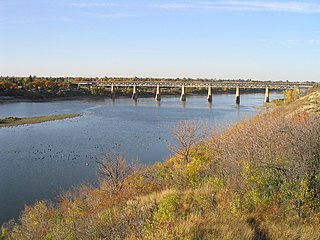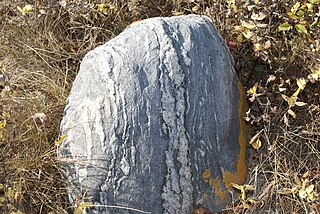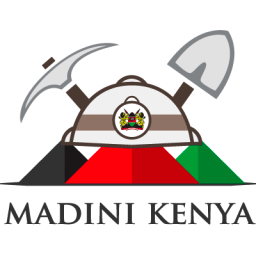Related Research Articles

Mining is the extraction of valuable minerals or other geological materials from the Earth, usually from an ore body, lode, vein, seam, reef or placer deposit. These deposits form a mineralized package that is of economic interest to the miner.

The Saskatchewan River is a major river in Canada, about 550 kilometres (340 mi) long, flowing roughly eastward across Saskatchewan and Manitoba to empty into Lake Winnipeg. Through its tributaries the North Saskatchewan and South Saskatchewan, its watershed encompasses much of the prairie regions of central Canada, stretching westward to the Rocky Mountains in Alberta and northwestern Montana in the United States. It reaches 1,939 kilometres (1,205 mi) to its farthest headwaters on the Bow River, a tributary of the South Saskatchewan in Alberta.

Prospecting is the first stage of the geological analysis of a territory. It is the physical search for minerals, fossils, precious metals or mineral specimens, and is also known as fossicking.

The Athabasca Basin is a region in the Canadian Shield of northern Saskatchewan and Alberta Canada. It is best known as the world's leading source of high-grade uranium and currently supplies about 20% of the world's uranium.
Fort de la Corne was one of the two French forts established on the Saskatchewan River in the 20 years between the end of La Vérendrye's push west from Lake Superior in 1731–1743 and the fall of New France in 1763.

Conflict resources are natural resources extracted in a conflict zone and sold to perpetuate the fighting. There is both statistical and anecdotal evidence that belligerent accessibility to precious commodities can prolong conflicts. The most prominent contemporary example has been the eastern provinces of the Democratic Republic of the Congo (DRC), where various armies, rebel groups, and outside actors have profited from mining while contributing to violence and exploitation during wars in the region.
Hoidas Lake is a remote northern Canadian lake which lies approximately 50 kilometers north of Uranium City, Saskatchewan. Named in honor of Irvin Frank Hoidas, a Royal Canadian Air Force pilot officer killed in action during the Second World War when his Stirling W-7520 crashed near the Belgian town of Saint-Truiden, it is the site of Canada's most advanced rare-earth element (REE) mining project.
The Fort à la Corne Provincial Forest is a mixed-wood forest conservation area in Saskatchewan, Canada. It is east of the city of Prince Albert and just north of the James Smith First Nation. The fort takes its name for a historic Hudson's Bay Company post in the area. Recently the area has been subject to diamond exploration by various companies including Shane Resources, United Uranium, and Shore Gold.
The mineral industry of Russia is one of the world's leading mineral industries and accounts for a large percentage of the Commonwealth of Independent States' production of a range of mineral products, including metals, industrial minerals, and mineral fuels. In 2005, Russia ranked among the leading world producers or was a significant producer of a vast range of mineral commodities, including aluminum, arsenic, cement, copper, magnesium compounds and metals, nitrogen, palladium, silicon, nickel and vanadium.

Mining is the biggest contributor to Namibia's economy in terms of revenue. It accounts for 25% of the country's income. Its contribution to the gross domestic product is also very important and makes it one of the largest economic sectors of the country. The majority of revenue comes from diamond mining.
Star Uranium is a Canadian resource company with its head office in Saskatoon, Saskatchewan. The company is focused on the acquisition, exploration and development of uranium, diamond and other precious metal properties.

The geology of Saskatchewan can be divided into two main geological regions, the Precambrian Canadian Shield and the Phanerozoic Western Canadian Sedimentary Basin. Within the Precambrian shield exists the Athabasca sedimentary basin. Meteorite impacts have altered the natural geological formation processes. The prairies were most recently affected by glacial events in the Quaternary period.
Geo-Mineral Exploration Corporation is an environmentally-sensitive exploration, acquisition, and merger company, which examines the viability of consolidating historic underground mining properties into small-scale specialty production alliances. The Geo-Mineral Corporation and its independent affiliates, are fully American-owned and operated.

Ross Stanfield was a self-styled mining promoter based in Calgary, Alberta, Canada. Mr. Stanfield had been active in the industry at least since the mid-1970s.1 In 1964, he and his business partner at the time, John Hilton, optioned property near Williams Lake, British Columbia to a penny stock company called Gibraltar Mines Ltd. Together with senior partner Placer Developments Ltd., Gibraltar Mines Ltd. eventually brought the Gibraltar Mine, a current holding of Taseko Mines Limited and the second largest copper mine in Canada, into production in 1972.2
Mauritania's mineral sector was dominated by iron ore mining and beneficiation. Other mineral commodities produced in the country included cement, copper, gold, gypsum, petroleum, salt, and steel. The Ministère des Mines et de l’Industrie was the Government agency responsible for enacting the Mining Code and for the coordination of all activities in the mining sector. The Direction des Mines et de la Géologie was the entity responsible for promoting the mineral sector and for providing geologic and mining information to potential investors; the Direction des Hydrocarbures was in charge of the development of the petroleum sector; and the Office Mauritanien des Recherches Géologiques was the Government entity responsible for evaluating areas of mineral potential for exploration. Société Nationale Industrielle et Minière (SNIM) was responsible for iron ore production and benefciation.

Hathor Exploration Limited is a uranium exploration company based in Vancouver, British Columbia, Canada. Its exploration office is located in Saskatoon, Saskatchewan, Canada. Hathor's exploration projects concentrate on properties within the Athabasca Basin of Northern Saskatchewan, Canada.

Tahoe Resources Inc. was a mining company and intermediate precious metals producer with silver and gold mines in Canada, Guatemala and Peru. It was founded in Vancouver, British Columbia by Kevin McArthur, former CEO of Glamis Gold and Goldcorp. Incorporated in British Columbia, Canada, the company's U.S. headquarters is located in Reno, Nevada.

Tanzania is a land rich in minerals. Mining makes up more than 50% of the country's total exports, of which a large part comes from gold. The country has gold reserves of 45 million ounces, generating revenue of over a billion USD. Diamonds are also found in significant amounts. Since it was opened in 1940, the Williamson diamond mine has produced 19 million carats (3,800 kg) of diamonds. Gemstones, nickel, copper, uranium, kaolin, titanium, cobalt and platinum are also mined in Tanzania. Illegal mining and corruption are ongoing problems. In 2017, the government passed a series of bills aimed at increasing revenue from minerals after a scandal which caused the dismissal of the Minister for Energy and Minerals.

The Ministry of Mining of the Republic of Kenya is a Kenyan government ministry that oversees the Mineral sector in the country.
References
- ↑ "Company Profile for United Uranium Corp (CA;UUC)" . Retrieved 2008-10-17.
| This article about a mining-related corporation or company is a stub. You can help Wikipedia by expanding it. |